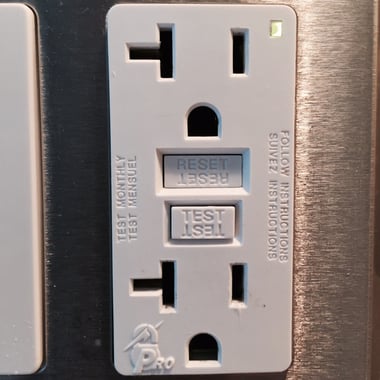 Prior to the invention of ground-fault circuit interrupters (GFCI) and other electrical plug and circuit innovations, electrical shocks and burns were fairly common. Even today, thousands of Americans are shocked and/or burnt in their homes as a result of faulty electrical switches, cords and plugs, as well as outdated or misused outlets.
Prior to the invention of ground-fault circuit interrupters (GFCI) and other electrical plug and circuit innovations, electrical shocks and burns were fairly common. Even today, thousands of Americans are shocked and/or burnt in their homes as a result of faulty electrical switches, cords and plugs, as well as outdated or misused outlets.
The installation of GFCI outlets, a building code requirement for kitchens, bathrooms and elsewhere in the home, significantly reduce the number of electrical injuries and fatal electrocutions that occur in American homes each year. In addition to human health and well-being, GFCIs also reduce electrical fires, which cause more than 400 deaths in the U.S. annually.
So what exactly are these GFCI miracle workers and where and when should you use them in Chicago kitchen and bathroom remodeling?
Basic Facts About GFCIs for Your Chicago Kitchen and Bath Remodeling Project
The following information will help you learn how a GFCI differs from a standard outlets as well as why they are so important for kitchen and bathroom counter locations.
How is a GFCI outlet different?
In order to understand how a GFCI outlet is different than a traditional outlet, you need to refresh your memory about electricity and how it behaves. The Number One rule for electricity is that is always looks for a path into the ground. Whether the electrical current is made by Mother Nature (lightning bolt) or humans (a spark from your blender), this rule never changes. Electricity also experiences a stronger draw to some materials than others. These materials are called conductors, and include things like metal, water, trees and humans (we're water too!).
A ground fault occurs when electricity escapes its intended path (your home's electrical wiring system, for example) and finds a different path to the ground. In areas like kitchens and bathrooms - where water and people are often present - that path can quickly become you or a member of your household. That's where a GFCI outlet comes in.
Back in 1961, a professor at Cal Berkeley invented an outlet that could monitor differences in electrical currents flowing into or out of anything plugged into it. As soon as the current exceeds 5 milliamps, the GFCI immediately shuts off power flow in case a ground fault is occurring. These outlets can be easily reset if they're tripped.
Where do GFCI outlets have to be installed?
This simple but effective invention is now required by the National Electric Code for all new kitchens, wet bar sinks, bathrooms, laundry and utility sinks, unfinished basements, crawl spaces, garages, and outdoor receptacles. These spaces all have one thing in common: regular and potential exposure to water or moisture that would cause an electrical shock, burn or fire to occur.
If you're planning a Chicago kitchen or bathroom remodel in an older home, one where GFCIs aren't the norm, your contractor is obligated to bring applicable outlets in the remodeling locations to code.
Meet with Kitchens & Baths Unlimited to attractively integrate GFCIs into your upcoming remodel.




